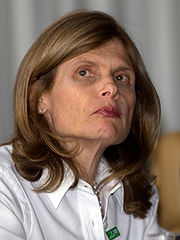
Zélia Cardoso de Mello
Encyclopedia

São Paulo
São Paulo is the largest city in Brazil, the largest city in the southern hemisphere and South America, and the world's seventh largest city by population. The metropolis is anchor to the São Paulo metropolitan area, ranked as the second-most populous metropolitan area in the Americas and among...
, b. September 20, 1953 in São Paulo
São Paulo
São Paulo is the largest city in Brazil, the largest city in the southern hemisphere and South America, and the world's seventh largest city by population. The metropolis is anchor to the São Paulo metropolitan area, ranked as the second-most populous metropolitan area in the Americas and among...
) served as Brazil
Brazil
Brazil , officially the Federative Republic of Brazil , is the largest country in South America. It is the world's fifth largest country, both by geographical area and by population with over 192 million people...
's Minister of Economy from 1990 to 1991 under Fernando Collor de Mello
Fernando Collor de Mello
Fernando Affonso Collor de Mello was the 32nd president of Brazil from 1990 to 1992, when he resigned in a failed attempt to stop his trial of impeachment by the Brazilian Senate...
(no relation). She was married to Brazilian comedian
Comedian
A comedian or comic is a person who seeks to entertain an audience, primarily by making them laugh. This might be through jokes or amusing situations, or acting a fool, as in slapstick, or employing prop comedy...
Chico Anysio
Chico Anysio
Chico Anysio, born Francisco Anysio de Oliveira Paula Filho is a Brazilian actor, comedian, writer and composer. He is the brother of the late actress Lupe Gigliotti. Anysio is considered one of the greatest and most talented names of Brazilian comedy of all time.- Television :* 1973/80 - Chico...
, with whom she has two children, Rodrigo and Victoria. The couple divorced in 1998.
Zélia Cardoso de Mello worked in the academic, public and private sectors in Brazil. Her political career began in 1986 when Dilson Funaro, the Minister of Finance of Brazil, invited her to join his Economic Advisory Team as Director of the National Treasure Dept. In 1990 Cardoso de Mello was appointed the National Minister of Economy, Finance and Planning of Brazil under president Fernando Collor de Mello
Fernando Collor de Mello
Fernando Affonso Collor de Mello was the 32nd president of Brazil from 1990 to 1992, when he resigned in a failed attempt to stop his trial of impeachment by the Brazilian Senate...
.
In 1995 she moved to New York
New York
New York is a state in the Northeastern region of the United States. It is the nation's third most populous state. New York is bordered by New Jersey and Pennsylvania to the south, and by Connecticut, Massachusetts and Vermont to the east...
and became a visiting scholar at the Institute of Latin America and Iberian Studies at Columbia University
Columbia University
Columbia University in the City of New York is a private, Ivy League university in Manhattan, New York City. Columbia is the oldest institution of higher learning in the state of New York, the fifth oldest in the United States, and one of the country's nine Colonial Colleges founded before the...
. Since 1998, Cardoso de Mello has served executive positions at several major financial advisory companies focused on Brazil, including Global Accessinvestments, Orix and Lily Pond Capital. Her academic career was entirely accomplished in the School of Business and Economics at the University of São Paulo, where she received her college degree, Doctorate, and served as university professor. She is currently a partner at New York-based Aquila Associates.
Finance minister
As minister, Zélia was responsible for the implementation of the Plano CollorPlano Collor
The Collor Plan , is the name given to a collection of economic reforms and inflation-stabilization plans carried out during the presidency of Fernando Collor de Mello of Brazil, between 1990 and 1992...
, which combined fiscal and trade liberalization with radical inflation stabilization measures. A monetarist inflation stabilization was coupled with an industrial and foreign trade reform program, the Industrial and Foreign Trade Policy (English: Política Industrial e de Comércio Exterior), better known as PICE, and a privatization program dubbed the "National Privatization Program" (Portuguese: Programa Nacional de Desestatização), better known as the PND. The PICE was geared towards opening the Brazilian marketing to foreign competition while simultaneously fostering domestic innovation, whereas the PND was the first large-scale privatization program in Brazil, generating nearly US$4 billion for the government and privatizing 18 different state-owned enterprises.
According to Carlos Eduardo Carvalho, from Departamento de Economia da Pontifícia Universidade Católica de São Paulo : The Collor Plan itself began to be formatted by the president-elects advisors at the end of December 1989, after his victory in the runoff election. The final draft was probably strongly influenced by a document discussed by the advisors of PMDB party candidate Ulysses Guimarães, and later by advisors of PT party candidate Luís Inácio Lula da Silva, during the period between the general election and the runoff. In spite of the differences in their general economic strategies, these competing candidates failed to develop their own stabilization policies at a time of rapid price increases and risk of hyperinflation during the second half of 1989. The proposal to block liquidity originated in academic debate and was imposed upon the main presidential candidacies.

